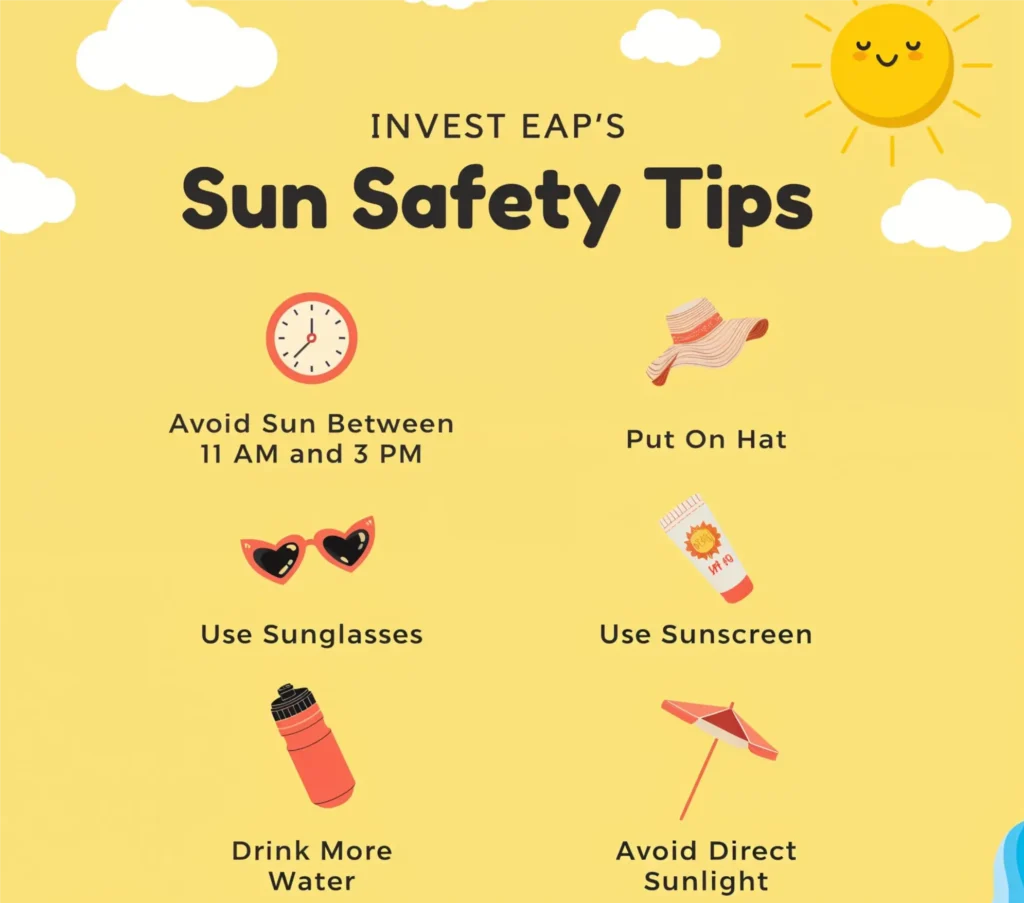Spending time in the sun can feel like the ultimate freedom beach weekends, rooftop brunches, morning jogs. But while sunshine fuels good moods and vitamin D, it also brings risks if you’re not careful. “5 ways to stay safe in the sun” isn’t just summer advice it’s essential self-care. Think of it as a proactive step, much like choosing the right gastroenterology treatment: protecting what’s inside by taking care of what’s outside.
Why Sun Safety Should Be on Your Radar This Summer
When temperatures rise and daylight stretches longer, it’s tempting to soak in every golden hour. But this summer, keeping sun safety top of mind is more than just a seasonal suggestion it’s a necessity. Whether you’re commuting to work, grabbing coffee outdoors, or squeezing in a weekend getaway, daily exposure to UV rays adds up quickly. Understanding the 5 ways to stay safe in the sun can help you enjoy your time outside without risking your health.
- Unprotected sun exposure leads to premature skin aging. Fine lines, dark spots, and skin texture changes often show up earlier in people who skip daily sun protection. This is especially true for professionals constantly on the move or working in outdoor environments.
- UV radiation increases the risk of skin cancer even on cloudy days. Invisible rays can penetrate clouds and glass, meaning even indoor exposure or overcast mornings carry hidden dangers. Long-term neglect can escalate into serious health conditions that disrupt daily life.
- Sunburns aren’t just a summer inconvenience they’re a sign of DNA damage. A single blistering sunburn in your 20s can double your risk of developing melanoma later in life. Preventive steps now can reduce painful consequences down the line.

5 ways to stay safe in the sun
Here’s how you can put the tips to stay safe in the sun into action without sacrificing your lifestyle. These practical steps are ideal for anyone balancing work, travel, and social time, especially under intense summer heat. If you’ve ever wondered how to protect skin during summer, these methods offer everyday protection that fits seamlessly into your routine.
1. Choose the Right Sunscreen It’s More Than Just SPF
- Look for “Broad-Spectrum” Protection: This ensures you’re shielded from both UVA (aging) and UVB (burning) rays.
- Don’t Just Rely on High SPF: SPF 30 is often enough if applied correctly and reapplied every two hours.
- Apply Generously: Use a shot-glass amount for your body and a nickel-sized dab for your face.
- Know Your Skin Type: Mineral sunscreens with zinc oxide are gentler for sensitive or acne-prone skin.
- Make It a Habit: Use sunscreen daily, even on cloudy days or when you’re indoors near windows.
2. Dress Smart: Your Style Can Save Your Skin
- Wear UPF Clothing: Many brands offer stylish, breathable clothes with UV protection woven into the fabric.
- Cover High-Risk Areas: Long sleeves, wide-brimmed hats, and high collars shield often-burned spots like the shoulders and neck.
- Choose Light Colors: White, beige, and pastels reflect heat and UV rays, keeping you cooler.
- Don’t Forget Accessories: UV-blocking sunglasses protect your eyes and the delicate skin around them.
- Stay Comfortable: Natural fabrics like cotton and linen are breathable and reduce skin irritation are some 5 ways to stay safe in the sun
3. Stay in the Shade Especially During Peak Hours
- Time It Right: The sun’s rays are strongest between 10 AM and 4 PM—plan activities before or after.
- Use Physical Barriers: Sit under trees, awnings, or umbrellas when outdoors for extended periods.
- Create Your Own Shade: Carry a foldable sun umbrella or wide-brimmed hat for quick relief.
- Be Mindful of Reflection: Surfaces like water, sand, and pavement bounce UV rays back at you.
- Combine with Sunscreen: Shade reduces direct exposure, but sunscreen is still necessary.
4. Hydrate Like It’s Your Job
- Drink Before You’re Thirsty: If you wait until you’re parched, you’re already dehydrated.
- Add Electrolytes: Include coconut water or electrolyte tablets during prolonged heat exposure.
- Keep Water Visible: Carry a reusable bottle everywhere as a visual cue to keep sipping.
- Watch for Dehydration Signs: Dry lips, dizziness, and dark urine are early warnings.
- Boost Skin Resilience: Hydrated skin is less likely to flake or react harshly to sun exposure.
5. Listen to Your Body: Know When It’s Time to Cool Down
- Recognize Warning Signs: Fatigue, headache, dizziness, and nausea mean your body needs a break.
- Find Cool Spaces: Indoors with fans or AC is ideal; even shady spots help lower your body temp.
- Use Cooling Tools: Wet towels, cooling face mists, or neck wraps can offer fast relief.
- Don’t Push Through Heat: Overexertion in the sun can lead to heatstroke, which is dangerous.
- Prioritize Breaks: Regular pauses prevent overheating and help your skin recover from UV stress.these are the some Tips to Protect Your Skin This Summer
Everyday Sun Safety: Small Habits, Big Impact
- Make Sunscreen Part of Your Morning Routine: Just like brushing your teeth, applying sunscreen should be a non-negotiable part of your day. Choose a lightweight, non-greasy formula that layers well under makeup or moisturizers. Applying it each morning, especially to your face, neck, and arms, goes a long way in learning how to protect skin during summer.
- Keep Extra Protection in Your Bag or Desk: Whether it’s a mini sunscreen, a foldable hat, or UV-protective sunglasses, having sun safety tools within reach helps you stay prepared. These small backups are invaluable when you’re unexpectedly outside longer than planned. Being consistent about sun safety doesn’t require big efforts—just smart preparation.
- Reapply Sunscreen When Outdoors: Sunscreen isn’t a one-time fix reapply every two hours or after sweating or swimming. If you’re commuting or working outside, set reminders on your phone. Even walking to grab lunch in the sun can expose you to harmful rays.
- Plan Your Day Around the Sun: If you have flexibility, schedule walks, workouts, or errands for early morning or late afternoon. Avoiding midday sun, when rays are most intense, is a simple and powerful strategy for how to protect from sun in summer. Using public shade like covered walkways or trees also adds a layer of defense.
- Hydrate and Nourish Your Skin: Drinking plenty of water keeps your skin cells healthy and improves their ability to repair sun damage. Include antioxidant-rich foods like berries, tomatoes, and green tea in your diet—they help fight the oxidative stress caused by UV rays. Small dietary changes support your skin’s resilience from the inside out.
Closing Thoughts: Sun-Safe Living Is Smart Living
Sun protection isn’t just for sunny days it’s a daily habit that supports lifelong skin health. Here’s how to make it part of your routine while learning how to protect from sun in summer:
- Prevention Beats Repair: A few minutes in the sun can cause lasting damage. Daily habits like sunscreen and protective clothing go a long way.
- Small Actions, Big Results: Reapplying sunscreen or wearing a hat may seem minor, but these steps build powerful protection over time.
- It’s Not Just a Vacation Thing: Everyday activities walking, driving, sitting by a window expose you to UV rays. Stay protected always.
- Lead by Example: When you practice sun safety, others notice. Your habits can inspire smarter choices in your circle.
- Respect Your Skin: Skin is your body’s first defense. Protecting it shows self-care and guards against premature aging and health risks.
Risk Factors for Harmful Effects of UV Radiation
Understanding the risk factors for UV-related damage is essential when applying tips to protect your skin this summer. Certain elements increase your vulnerability and call for extra caution under the sun.
- Fair or Light Skin Tones: People with lighter skin have less melanin, which offers some natural protection from UV rays. As a result, they are more prone to sunburn, skin aging, and skin cancer, making daily sun protection a must.
- Family History of Skin Cancer: If skin cancer runs in your family, your risk of developing it from UV exposure increases. Even moderate sun exposure should be approached cautiously, especially during peak hours.
- High-Altitude or Equatorial Locations: The closer you are to the equator or the higher the elevation, the more intense the UV radiation. Living or vacationing in such places requires extra vigilance with hats, sunscreen, and protective clothing.
- Certain Medications and Health Conditions: Drugs like antibiotics, acne treatments, or birth control pills can increase sun sensitivity. Individuals undergoing treatments like chemotherapy also have heightened risk and must adopt stricter sun protection habits.
- Outdoor Occupations or Hobbies: Landscapers, construction workers, and athletes often spend prolonged hours under direct sunlight. Long sleeves, wide-brimmed hats, and reapplying sunscreen every two hours are essential habits for them.
- Tanning Beds and Artificial UV Sources: Exposure to artificial UV rays, such as from tanning beds, can be as harmful as the sun itself. Regular use leads to premature aging, DNA damage, and increased risk of melanoma, especially in younger individuals.
Conclusion
Taking care of your skin uaing these 5 ways to stay safe in the sun doesn’t mean avoiding the outdoors it means being smart while you enjoy it. From picking the right sunscreen to knowing when to step into the shade, these simple steps empower you to live confidently under the sun. Whether you’re heading to work, running errands, or spending the weekend outdoors, sun safety should never be an afterthought.
Make it a part of your lifestyle. Protecting your skin now is the key to staying healthy, energized, and glowing for years to come. So the next time you step outside, remember: the sun is powerful but so are you.
Read Also: Healthy Diet for Hair Growth
